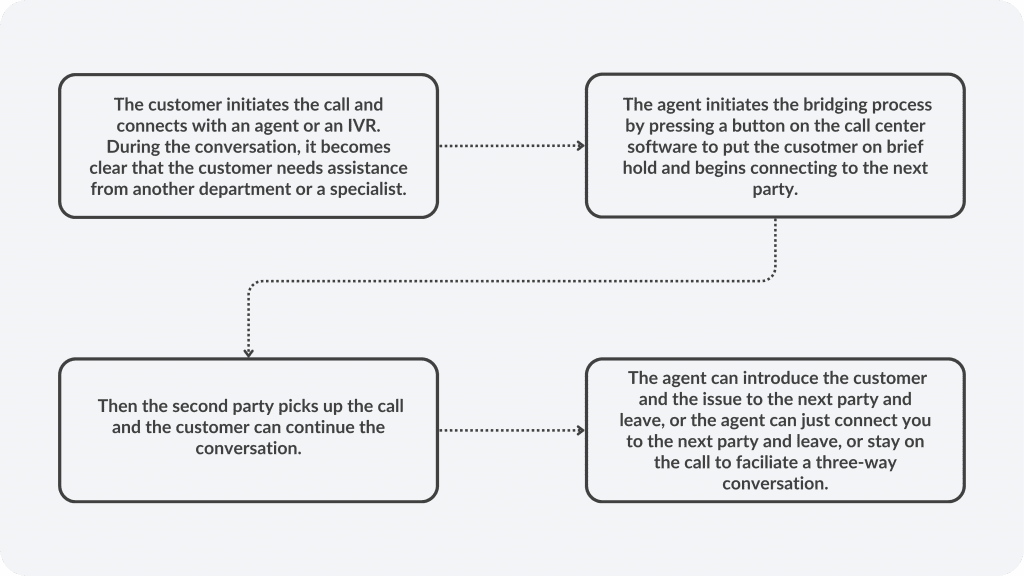Call Bridging in Call Centers: How It Works and Why It Matters in CX
You call customer care, and an IVR greets you and gives you various options from which to choose. You choose the department you want to reach, and the IVR patches you up with an agent in that department.
You call the customer care, and an agent greets you. You explain the issue or challenge for which you need help. The agent figures that intervention from a specialist is required, and the agent seamlessly transfers you to the expert for the resolution. You don’t have to disconnect or redial another number.
These two scenarios are ‘call bridging’ in a nutshell. You typically use them to offer better customer experiences when you are trying to transfer calls, conferencing, and escalations to provide faster and better service.
How Does Call Bridging Work in Call Center?
Call bridging is a simple technology that most call center software providers offer. This is how it works:

Call Bridging – Use Cases
1. Escalations
You bought a kitchen set from an online retailer. You didn’t receive the item on the promised date, so you called their customer support to inquire about the late delivery.
The agent checks the system and understands that the problem is related to the warehouse.
Instead of asking you to call the warehouse team, the agent uses call bridging to transfer the call to the warehouse specialist while staying on the line to explain the situation and introduce you.
The warehouse specialist explained the situation, told you the reasons for the late delivery, and assured you that they would stick to the new delivery timelines.
As a customer, you did not have to explain the issue again, and the entire process was seamless.
2. Technical Support
Your Internet connection is not working, so you call customer support. The first-tier agent can troubleshoot only basic issues, and when the problem turns out to be more complex, the agent uses call bridging to transfer your call to the network specialist.
After the specialist joins the call, the agent introduces you and explains the troubleshooting done so far before leaving the conversation.
You feel valued as you are not mindlessly transferred between extensions, and the agent swiftly handles the issues.
3. Telemedicine
A patient calls the telemedicine consultation team to inquire about some symptoms. The first doctor assesses the symptoms and understands that the patient needs to speak with a specialist.
Instead of asking the patient to set up another appointment and speak to the specialist, the doctor uses call bridging to connect the patient directly to the specialist. The doctor explains the symptoms to the specialist and stays on the call to facilitate the discussion.
The patient gets immediate specialist consultation without delays, and the patient is happy with the outcomes.
4. Bill Dispute Resolution
Your credit card company charges you a late payment fee for the previous month’s schedule as you missed the deadline by a few days.
You have been a customer of the credit card company for more than ten years, and this was probably the first time you missed the deadline, and you want a waiver of the late payment fee.
So you call their customer support and ask for a waiver. The agent understands the situation, but he needs approval from a senior manager before processing your request. Instead of asking you to call back, he puts you on hold and uses call bridging to reach the senior manager to get approval for the waiver.
Then he comes back to you and tells you the waiver is processed, and you don’t have to pay the late payment fee as a part of your bill payment.
The use cases for call bridging are endless. I have provided just four of them so that we can appreciate the role of call bridging in a call center.
What Are the Advantages of Using Call Bridging?
We have discussed some of the advantages of call bridging subtly as a part of the previous section.
So, I am going to give you some statistics that would allow you to appreciate the impact of call bridging.
- According to research by American Express, 60% of customers feel frustrated when they have to explain their issue to multiple people repeatedly. Call bridging ensures that you don’t have to do this and ensures that the conversations are handled smoothly.
- An SQM report states that for every 1% improvement in first call resolution (FCR), call centers can see a 1% increase in customer satisfaction. Call bridging contributes to this by transferring customers to the right department without having to call back or wait to follow up.
- A study by Microsoft states that 73% of customers expect businesses to understand their needs and expectations. Call bridging enables departments to collaborate without disrupting the customer’s experience and meet their expectations.
- A PWC study found that 32% of customers would stop doing business with a brand they loved after just one bad experience. Call bridging helps avoid such negative experiences by resolving issues quickly and efficiently.
- According to Salesforce, 67% of customers use multiple channels to resolve their issues, and they expect a unified experience across these channels. Call bridging ensures that when a customer moves from chat to voice or from one department to another, the experience is seamless.
- McKinsey research shows that 70% of buying experiences are based on how the customer feels they are being treated. Call bridging can be used to connect customers with sales agents after an exceptional service call.
Call bridging helps organizations put customers in the middle of customer experiences. It makes the entire process of resolution a seamless experience for the customers as they are protected from doing the heavy lifting of reaching the right department or agent.
The best part is you never have to repeat yourself, as that aspect is handled effectively by the agent or the system that does the transfer.
Happy experiences mean happy customers. Call bridging is the first step to providing happy experiences.
